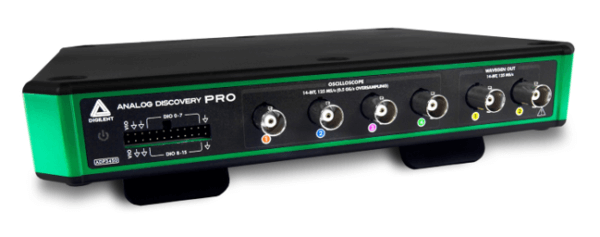Industry 4.0 runs on a plethora of software, mid-ware, and hardware solutions that enable machine-to-machine, as well as, machine-to-human communications within the shop floor. For software, cloud computing, the digital twin, and other digital transformation solutions provide the computing power for data analysis. For hardware, edge computing solutions or industrial IoT devices serve as data collection, display, and connectivity tools – and USB oscilloscopes provide enterprises with a means to extend their IoT application capabilities.

Oscilloscopes have always been crucial equipment testing tools within the industrial sector. End-users have leveraged their signal and electrical characteristics measurement capabilities to monitor equipment performance, but the inclusion of the USB has taken its usability to the next level. USB, along with Ethernet and WiFi, all of which provide a universal connection from diverse hardware to external devices, make it possible to apply the USB oscilloscope as an edge computing tool across the industrial sector. Hence, industrial enterprises can leverage its use within IoT applications in the following ways:
- To Optimize Real-time Data Collection – Diverse Industry 4.0 business models rely on collected real-time data to gain insight into system performances. Examples of such business models include predictive maintenance, remote machine monitoring, and data-driven production optimization. Using predictive maintenance as an example, capturing frequency data to note discrepancies provides insight into the performance of electrical equipment. Integrating USB oscilloscopes into available IoT frameworks empowers technicians with precise details on machine performance. The real-time collection of electrical signals ensures performance drops can be monitored and traced to their causation factors. Insight into the causation factors and the duration of downtime provides the data for developing predictive maintenance strategies. Attaching USB oscilloscopes to edge computing solutions also provides these solutions with the real-time data they need to execute decentralized analytics.
- Visualizing Equipment Data and Remote Monitoring– The plug-and-play nature of the USB oscilloscope provides users with a means to visualize the signals and electrical data coming from the equipment. Attaching the USB oscilloscope to an IoT device allows it to leverage the visualization features of the IoT display. Hence, technicians on the average shop floor can visualize signals and the analysis associated with them in a language or the graphics they understand. The large display also makes it possible for the user to scrutinize every waveform thus improving error identification success rates. USB oscilloscopes also support condition monitoring, remote connectivity, and remote monitoring which are important concepts of Industry 4.0 during this post-pandemic era. In this capacity, the oscilloscope serves as an edge device that captures equipment data on the shop floor and transfers the captured data to a centralized platform. Hence, enterprises utilizing digital twins or an IoT platform receive crucial electrical data without having to step onto the shop floor. The ability to visualize electrical data, alongside other equipment-related data the IoT device captures, extends the analytical and remote monitoring capabilities of the IoT application. The insight gained from analyzing electrical data with interrelated data can help with improving diagnostic results, devising operational strategies, and optimizing equipment use.
- Improve Resource Efficiency – Optimizing machine utilization is a crucial aspect of Industry 4.0 and the first step to achieving this is understanding the equipment’s current performance status. An IoT application that tracks resource efficiency can expand its tracking capabilities by integrating a USB oscilloscope which ensures the signals the equipment emits is included in its efficiency review. The insight gained from the data the USB oscilloscope provides can be used as the current state statistics that are needed to improve equipment performance.
How Do You Choose the Right USB Oscilloscope for IoT?
Diverse criteria must be taken into consideration when choosing the perfect USB oscilloscope that meets your IoT applications requirement. Some key criteria include the following:
- Support for Operating Systems – IoT applications are expected to work within an interconnected framework, thus, devices within the IoT framework must come with extensive interconnectivity features. These interconnectivity features must support data transfer, visualization, and programming. The recommended choice should support the running of an operating system such as Linux in a standalone mode. The ability to run Linux empowers the user with programming features and the ability to import or export data.
- Portability and Durability – Devices used within the average shop floor must be compact and capable of withstanding the labor-intensive and ruggedness of the industrial environment. The device should also be compact enough to be placed alongside IoT devices without taking up too much space. USB oscilloscopes are generally portable and compact but much consideration should be given to their durability and ability to withstand interference.
- Cost and Integration– Finally, the purchasing and setup cost for integrating the USB oscilloscope to support IoT applications must be considered. For many enterprises, setting up a large IoT framework is a tedious affair thus the process of including an oscilloscope should be seamless.

Getting Started with the Right Oscilloscope
USB oscilloscopes are plug-and-play devices that extend the capabilities of IoT applications. Defining how you intend to apply the oscilloscope should be the first step in getting started. Insight into how you intend to use the oscilloscope then define the oscilloscope specifications and features to shop for. Hence, delivering on the interconnectivity, data collection, and analytics your Industry 4.0 business models require to be a success.

